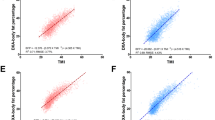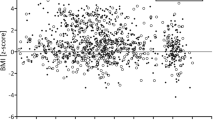Abstract
Background/Objectives:
To investigate the relationships between body mass index (BMI), body fatness, ethnicity, age and blood lipids.
Subjects/Method:
In a subsample (N=643) of the 2002 New Zealand Child Nutrition Survey (N=3275, age 5–14 years) consisting Māori (89 boys, 69 girls), Pacific (154 boys, 194 girls) and European (71 boys, 66 girls) ethnic groups, fat-free mass (FFM) was determined by bioimpedance analysis. FFM index (FFMI, FFM/height2), fat mass index (FMI, fat mass/height2) and percentage body fat (%BF) were derived. Plasma total cholesterol and high-density lipoprotein (HDL) cholesterol were measured in 515 (80%) of these children.
Results:
For the same BMI, %BF was lower in Pacific Island (P<0.0001) and Māori (P<0.0001) girls compared with European but for boys there were no ethnic differences. Cross-sectional analysis across ages using Hattori charts clearly showed sexual dimorphism with girls having a higher FMI, FFMI and BMI than boys by the age of 13 year. Both Pacific girls and boys showed upward trends in FFMI and FMI with age that were significantly higher than those of the other ethnicities. Adjusting for age, sex and ethnicity, %BF was a better predictor (R2=0.090, P=0.0002) of total cholesterol than BMI (R2=0.061, P=0.049) or waist (R2=0.075, P=0.013) while FFMI was the best predictor of HDL cholesterol (R2=0.15, P<0.0001) and waist was the best predictor of the total cholesterol/HDL cholesterol ratio (R2=0.17, P<0.0001).
Conclusions:
Measurements of body fat and indices of body fatness additional to BMI in multiethnic paediatric populations allow changes in fat mass and FFM to be tracked and improve the ability to predict dyslipidaemia.
This is a preview of subscription content, access via your institution
Access options
Subscribe to this journal
Receive 12 print issues and online access
$259.00 per year
only $21.58 per issue
Buy this article
- Purchase on Springer Link
- Instant access to full article PDF
Prices may be subject to local taxes which are calculated during checkout



Similar content being viewed by others
References
Baird J, Fisher D, Lucas P, Kleijnen J, Roberts H, Law C (2005). Being big or growing fast: systematic review of size and growth in infancy and later obesity. BMJ 331, 929.
Buchan IE, Bundred PE, Kitchiner DJ, Cole TJ (2007). Body mass index has risen more steeply in tall than in short 3-year olds: serial cross-sectional surveys 1988–2003. Int J Obes Related Metab Disord 31, 23–29.
Cruz ML, Shaibi GQ, Weigensberg MJ, Spruijt-Metz D, Ball GD, Goran MI (2005). Pediatric obesity and insulin resistance: chronic disease risk and implications for treatment and prevention beyond body weight modification. Annu Rev Nutr 25, 435–468.
Cunningham-Rundles S, McNeeley DF, Moon A (2005). Mechanisms of nutrient modulation of the immune response. J Allergy Clin Immunol 115, 1119–1128;quiz 1129.
Freedman DS, Khan LK, Mei Z, Dietz WH, Srinivasan SR, Berenson GS (2002). Relation of childhood height to obesity among adults: the Bogalusa Heart Study. Pediatrics 109, E23.
Freedman DS, Thornton JC, Mei Z, Wang J, Dietz WH, Pierson Jr RN et al. (2004). Height and adiposity among children. Obes Res 12, 846–853.
Haslam DW, James WP (2005). Obesity. Lancet 366, 1197–1209.
Hattori K, Tatsumi N, Tanaka S (1997). Assessment of body composition using a new chart method. Am J Hum Biol 9, 573–578.
McAnulty J, Scragg R (1996). Body mass index and cardiovascular risk factors in Pacific Island Polynesians and Europeans in New Zealand. Ethn Health 1, 187–195.
Ministry of Health (2003). NZ Food NZ Children, Key Results of the 2002 National Children's Nutrition Survey. Ministry of Health: Wellington.
Ministry of Health (2005). Influences in Childhood on the Development of Cardiovascular Disease and Type 2 Diabetes in Adulthood. Ministry of Health: Wellington,p 49.
Pietrobelli A, Lee RC, Capristo E, Deckelbaum RJ, Heymsfield SB (1999). An independent, inverse association of high-density-lipoprotein-cholesterol concentration with nonadipose body mass. Am J Clin Nutr 69, 614–620.
Rodriguez G, Moreno LA, Blay MG, Blay VA, Garagorri JM, Sarria A et al. (2004). Body composition in adolescents: measurements and metabolic aspects. Int J Obes Relat Metab Disord 28 (Suppl 3), S54–S58.
Rush EC, Puniani K, Valencia ME, Davies PS, Plank LD (2003). Estimation of body fatness from body mass index and bioelectrical impedance: comparison of New Zealand European, Maori and Pacific Island children. Eur J Clin Nutr 57, 1394–1401.
Salo P, Viikari J, Rask-Nissila L, Hamalainen M, Ronnemaa T, Seppanen R et al. (1999). Effect of low-saturated fat, low-cholesterol dietary intervention on fatty acid compositions in serum lipid fractions in 5-year-old children. The STRIP Project. Eur J Clin Nutr 53, 927–932.
Savendahl L, Underwood LE (1999). Fasting increases serum total cholesterol, LDL cholesterol and apolipoprotein B in healthy, nonobese humans. J Nutr 129, 2005–2008.
Schmitz KH, Jacobs Jr DR, Leon AS, Schreiner PJ, Sternfeld B (2000). Physical activity and body weight: associations over ten years in the CARDIA study. Coronary artery risk development in young adults. Int J Obes Relat Metab Disord 24, 1475–1487.
Schubert CM, Rogers NL, Remsberg KE, Sun SS, Chumlea WC, Demerath EW et al. (2006). Lipids, lipoproteins, lifestyle, adiposity and fat-free mass during middle age: the Fels Longitudinal study. Int J Obes Relat Metab Disord 30, 251–260.
Scragg R, Baker J, Metcalf P, Dryson E (1993). Serum lipid levels in a New Zealand multicultural workforce. NZ Med J 106, 96–99.
Thampy KG (1995). Hypercholesterolaemia of prolonged fasting and cholesterol lowering of re-feeding in lean human subjects. Scand J Clin Lab Invest 55, 351–357.
Van Itallie TB, Yang MU, Heymsfield SB, Funk RC, Boileau RA (1990). Height-normalized indices of the body's fat-free mass and fat mass: potentially useful indicators of nutritional status. Am J Clin Nutr 52, 953–959.
Weiss R, Dufour S, Taksali SE, Tamborlane WV, Petersen KF, Bonadonna RC et al. (2003). Prediabetes in obese youth: a syndrome of impaired glucose tolerance, severe insulin resistance, and altered myocellular and abdominal fat partitioning. Lancet 362, 951–957.
Wells JC (2000). A Hattori chart analysis of body mass index in infants and children. Int J Obes Relat Metab Disord 24, 325–329.
Wolfe RR (2006). The underappreciated role of muscle in health and disease. Am J Clin Nutr 84, 475–482.
Acknowledgements
We thank the Lion Foundation for the provision of funds to purchase the bioimpedance meters. We also thank children and their families for their cooperation; the Child Nutrition Survey Kaitiaki group and the Pacific Island Food and Nutrition Action group for their support; the Ministry of Health and Uniservices for helping make the measurements possible within the framework of the Child Nutrition Survey and the Auckland University of Technology contestable grants for funding.
Author information
Authors and Affiliations
Corresponding author
Rights and permissions
About this article
Cite this article
Rush, E., Scragg, R., Schaaf, D. et al. Indices of fatness and relationships with age, ethnicity and lipids in New Zealand European, Māori and Pacific children. Eur J Clin Nutr 63, 627–633 (2009). https://doi.org/10.1038/ejcn.2008.15
Received:
Revised:
Accepted:
Published:
Issue Date:
DOI: https://doi.org/10.1038/ejcn.2008.15
Keywords
This article is cited by
-
Association between serum vitamin D levels and visceral adipose tissue among adolescents: a cross-sectional observational study in NHANES 2011–2015
BMC Pediatrics (2022)
-
Do differences in compositional time use explain ethnic variation in the prevalence of obesity in children? Analyses using 24-hour accelerometry
International Journal of Obesity (2020)
-
Relationship between BMI and body fatness in three European countries
European Journal of Clinical Nutrition (2013)
-
Hattori Chart Based Evaluation of Body Composition and its Relation to Body Mass Index in a Group of Sri Lankan Children
The Indian Journal of Pediatrics (2012)



